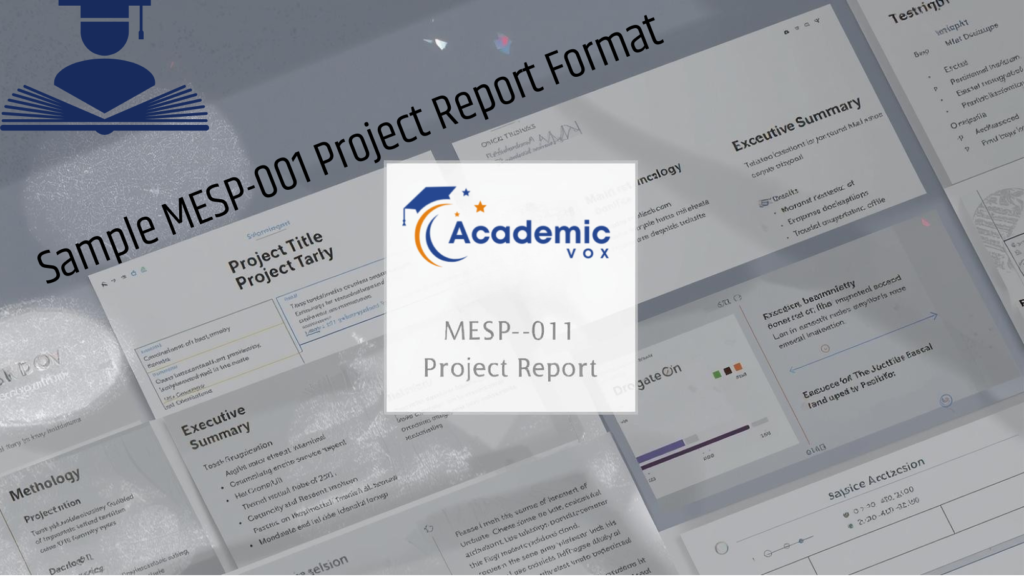Project Report Format
Introduction
The MESP-001 project is perhaps the most important element of the Master of Education (M.Ed.) course at IGNOU. It allows students to pursue independent research, apply theoretical concepts to educational problems, and showcase their academic abilities. But most students get confused between the MESP-001 project report format.
A properly organized report not only complies with IGNOU standards but also portrays clarity, organization, and professionalism. In this step-by-step guide, we will give you a MESP-001 project report sample format, structuring tips step by step, and vital guidelines to enable you to submit a flawless project.
This article has been presented as a guideline reference for IGNOU M.Ed. students with detailed descriptions, examples, and practical recommendations.
Why It Matters to Use the Right MESP-001 Report Format
- Complies with Academic Standards – IGNOU imposes strict evaluation criteria, and adherence to the format is mandatory.
- Makes it Readable – An organized report is quickly readable and assessable by examiners.
- Makes Presentation Better – Organized formatting showcases professionalism and hard work.
4. Prevents Rejection – Projects submitted without complying with IGNOU’s given format can get rejected or sent back for corrections.
General Guidelines for MESP-001 Report Writing
Before proceeding with the sample format, here are some general guidelines:
- Utilize A4 size white bond paper.
- Have a 1.5 line spacing with a 12-point Times New Roman font.
- Have 1-inch margins on every side.
- The reports should be 100–120 pages (research-dependent).
- Utilize spiral or hard binding for submission.
Put page numbers at the bottom center of the page.
Sample MESP-001 Project Report Format
Following is the recommended format of your project report:
1. Cover Page
The cover page must have:
- Project title
- Student name
- Enrollment number
- Program code (MESP-001)
- Guide/supervisor name
- Study center/region name
Session/year of submission
2. Certificate
A signed certificate from your project guide or supervisor stating that the work presented is original and has been done under their guidance.
3. Declaration
A student’s statement assuring that the project report is their own work and not copied or submitted elsewhere.
4. Acknowledgement
Expressing acknowledgement of the guidance, support, and assistance provided by your supervisor, family, friends, or institutions.
5. Table of Contents
A formatted list of all chapters, headings, subheadings, references, and appendices with page numbers.
6. List of Tables and Figures (if applicable)
If your project contains tables, charts, or figures, number them here for easy reference.
7. Abstract
A summary of 250–300 words that emphasizes:
- Research problem
- Objectives
- Methodology
- Key findings
Conclusions
8. Introduction (Chapter 1)
The introduction chapter provides the setting of your study. Insert:
- Background of the study
- Need and significance of the research
- Statement of the problem
- Objectives of the study
- Research questions/hypotheses
Scope and limitations
9. Review of Literature (Chapter 2)
This is a summary of what has been written about your topic.
- Summarize studies, theories, and models pertinent to your problem.
- Indicate gaps in research.
10. Research Methodology (Chapter 3)
This is an important section that describes how you carried out the study. Include:
- Research design (qualitative, quantitative, or mixed)
- Population and sample size
- Sampling methods employed
- Tools and instruments of data collection
- Data collection procedure
Data analysis methods
11. Data Analysis and Interpretation (Chapter 4)
- Organize collected data in tables, charts, and graphs.
- Logically interpret the findings.
- Compare the results with existing studies.
Explain the patterns or deviations.
12. Findings and Discussion (Chapter 5)
- Summarize key findings.
- Relate results to objectives.
- Discuss implications for the field of education.
Provide insights for policy makers, educators, and institutions.
13. Conclusion and Suggestions (Chapter 6)
- Conclude the study with a concise summary.
- Mention limitations of your research.
Provide recommendations for further studies.
14. References / Bibliography
- Follow APA 7th edition citation style.
Include all books, journals, articles, websites, and reports referred to in your research.
15. Appendices
Attach supporting documents such as:
- Questionnaire
- Interview schedule
- Observation checklist
Raw data sheets
Writing Guidelines for MESP-001 Project Report
- Clarity – Refrain from jargon; use simple academic English.
- Consistency – Use consistent formatting throughout the report.
- Authenticity – Do not plagiarize; use original analysis.
- Citations – Always credit authors you refer to.
5. Proofreading – Verify grammar, spelling, and formatting mistakes before submitting.
Example Format of MESP-001 Project (With Example)
Title Page Example:
“A Study on the Effectiveness of Blended Learning in Enhancing Academic Achievement among Secondary School Students”
Chapter Distribution Example:
- Chapter 1 – Introduction (10–12 pages)
- Chapter 2 – Review of Literature (15–20 pages)
- Chapter 3 – Methodology (10–12 pages)
- Chapter 4 – Data Analysis (25–30 pages)
- Chapter 5 – Findings & Discussion (15–20 pages)
Chapter 6 – Conclusion & Suggestions (5–8 pages)
Common Mistakes to Avoid
- Copy-pasting material from online sources.
- Ignoring IGNOU guidelines.
- Weak abstract or unclear objectives.
- Poor referencing style.
5. Submitting without proofreading.
Conclusion
The MESP-001 project report format is not only about presentation but also about research ethics and academic accuracy. If you follow the format outlined in this guide, you can make a high-quality project in line with IGNOU’s requirements. Just recall, a properly made project increases your credentials as a researcher and adds worthwhile value to your academic life.

